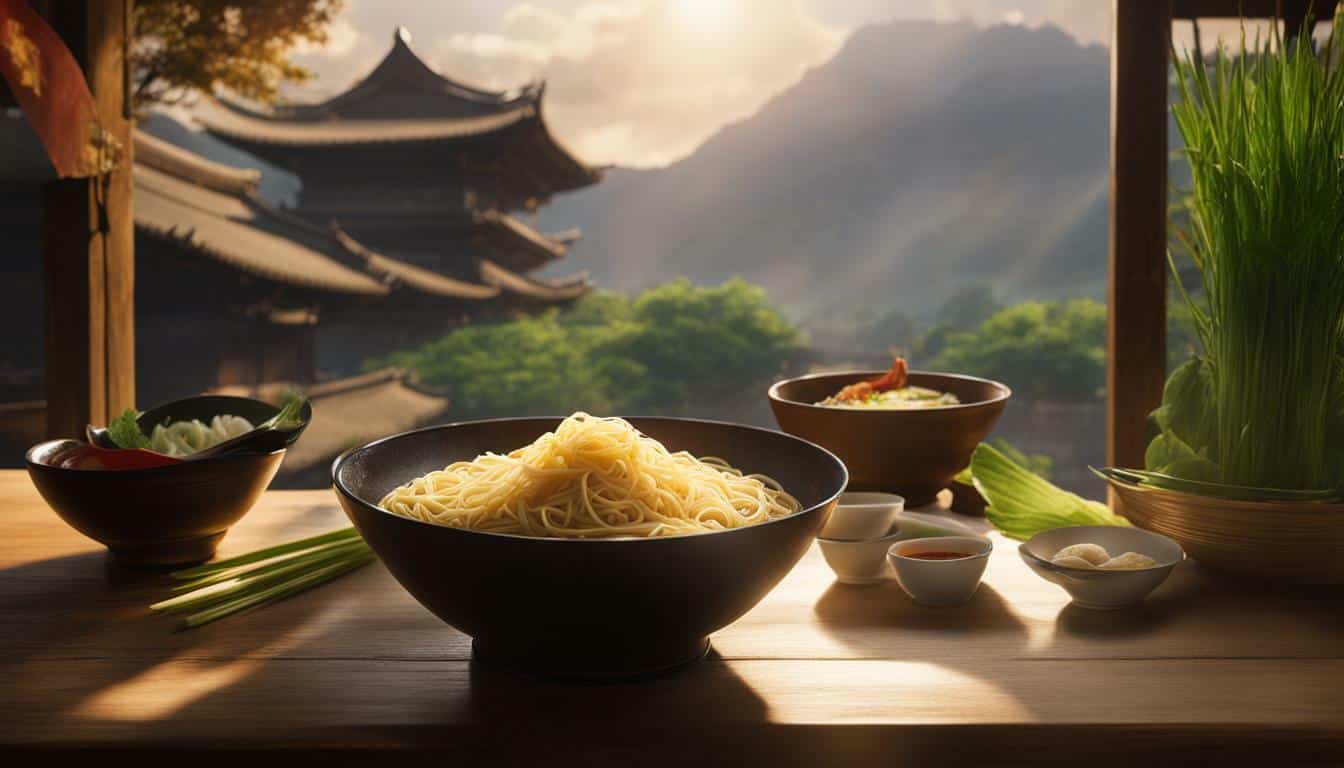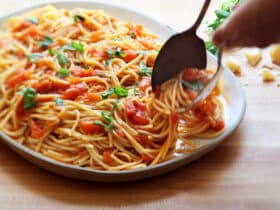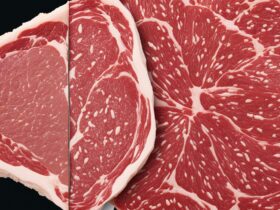From Italian spaghetti to Japanese udon, noodles are a popular dish enjoyed by millions worldwide. But where do these delicious, versatile strands of dough originate from? In this article, we will go on a journey of discovery into the history and origins of noodles.
Theories about the origins of noodles abound, with some historians claiming that they were invented in China over 4,000 years ago, while others argue that they were first made in the Middle East or Greece. However, regardless of their exact origins, it is clear that noodles have played an important role in the culinary cultures of many regions throughout history.
Join us as we delve into the fascinating story of noodles and explore the cultural influences that have shaped their development over time.
Key Takeaways
- Noodles have a rich history and cultural significance that spans many regions of the world.
- The origins of noodles are still debated, but it is clear that they have been a popular food for thousands of years.
- Throughout their history, noodles have been adapted and transformed by different cultures, resulting in a diverse range of delicious and unique dishes.
- The production of noodles has evolved over time, with modern-day factories using advanced techniques and machinery to produce them on a large scale.
- Noodles remain a beloved and versatile food today, with countless variations and types available to suit every taste and preference.
Noodle Origins: Unraveling the Past
It is widely debated where noodles originally come from, but there are several theories surrounding their creation. One of the most popular is that noodles were first created in China over 4,000 years ago during the Han Dynasty. According to legend, a Chinese chef named Caoimao accidentally created noodles when he mixed flour and water together and left the mixture out in the sun to dry.
Another theory suggests that noodles were originated in the Middle East, where they were made with unleavened bread dough and then dried in the sun. As trade routes opened between the Middle East and Asia, the noodle-making technique spread throughout the region.
Regardless of their exact origin, it is clear that noodles were a staple in many cultures throughout history. Early references to noodles have been found in texts from both China and Italy, with recipes dating as far back as the 1st century AD.
Historically, noodle production was a labor-intensive process, with dough being rolled out and cut by hand. However, with the advent of industrialization, automated machines have made noodle production much more efficient.
| Country | Noodle Type | Noodle Name |
|---|---|---|
| China | Wheat | Chow Mein |
| Japan | Rice | Ramen |
| Italy | Semolina | Spaghetti |
Despite the evolution of noodle production techniques, traditional handcrafted methods are still used in many parts of the world, such as in Italy with their famous pasta.
Understanding the history of noodles and their production provides insight into the cultural significance of this beloved food. Noodles continue to be a staple in many cuisines worldwide, from the savory broth of Japanese ramen to the spicy stir-fry of Chinese chow mein.
Join us in the next section, where we’ll trace the evolution of noodles from ancient times to the modern day.
Evolution of Noodles: From Ancient to Modern
Throughout history, noodles have evolved from basic food staples to culinary delights. Noodles are thought to have originated in China during the Han dynasty (206 BC–220 AD). The word “noodle” is derived from the German word “nudel” which means a long, thin strip of dough.
The ancient Chinese were known to make noodles out of all kinds of grains and vegetables, including wheat, rice, and mung beans. The process involved kneading the dough, rolling it out, and cutting it into strips or other shapes.
As noodles spread across Asia, different cultures began to put their own spin on the dish. In Japan, udon and soba noodles became popular, while in Korea, people enjoyed noodles made from sweet potato starch.
Throughout the ages, noodle-making techniques have continued to evolve. In the 12th century, for example, Italian pasta was first made by kneading a dough made from durum wheat flour and water.
Today, noodles can be found in many different shapes and sizes, from the thin and delicate vermicelli used in Vietnamese pho, to the thick and chewy udon noodles in Japanese hot pot. Noodle making has become a specialized art, with different techniques used for each type of noodle.
The process of noodle-making varies depending on the type of noodle being made. For example, ramen noodles are made by rolling out the dough, folding it over and over, and then cutting it into thin strips. On the other hand, Italian pasta is made by mixing semolina flour with water and then shaping it into different forms using a pasta machine.
Overall, the evolution of noodles has been a fascinating journey through time and culture. From its origins in China to its popularity in countries around the world, noodles continue to be an important part of many people’s diets today.
Noodles in Different Cultures: A Worldwide Love
Noodles hold a special place in the hearts and stomachs of people from all around the world. From the thin and delicate vermicelli in Vietnamese pho to the thick and chewy udon in Japanese ramen, noodles take on many different forms and flavors depending on the culture.
One of the best things about noodles is the variety of dishes that they can be used in. In China, savory dan dan noodles are a popular dish that is served with spicy ground pork and a flavorful sauce. In Italy, pasta dishes like spaghetti carbonara are staples in many households. And who can forget Pad Thai, the famous street food of Thailand made with rice noodles, tamarind sauce, shrimp, and peanuts?
Types of Noodles
There are countless types of noodles used in different cuisines around the world. Some popular ones include:
- Ramen: A Japanese noodle dish made with a savory broth and topped with ingredients like char siu pork, nori, and soft-boiled eggs.
- Soba: A thin Japanese noodle made from buckwheat flour and often served cold with a dipping sauce.
- Spaghetti: A long, thin pasta noodle that originated in Italy and is commonly served with tomato sauce and meatballs.
- Mi Quang: A Vietnamese noodle dish made with thick, chewy noodles and topped with pork, shrimp, herbs, and peanuts.
Noodle Recipes from Around the World
Here are a few noodle recipes from different cultures to try at home:
- Pad See Ew (Thailand): A stir-fry dish made with wide rice noodles, sweet soy sauce, and vegetables like Chinese broccoli and carrots.
- Jajangmyeon (Korea): A noodle dish made with thick and chewy noodles and topped with a savory black bean sauce, meat, and vegetables.
- Chicken Noodle Soup (United States): A classic soup made with egg noodles, chicken broth, and vegetables like carrots and celery.
Whether you’re trying out a new noodle recipe at home or slurping up some classic ramen at your favorite restaurant, there’s no denying the worldwide love for these delicious and versatile noodles.
From Ingredients to Factories: The Noodle Production Process
As we explore the rich history and cultural significance of noodles, it’s essential to understand the noodle production process. Noodle production begins with the ingredients, which may vary depending on the type of noodle being made. The main ingredients include flour, water, salt, and sometimes eggs.
The first step in noodle production is mixing the ingredients into a dough. The dough is kneaded and then rolled out into a long, thin sheet. The sheet is then cut into the desired size and shape of noodles. The noodles are then left to dry before they are cooked or packaged for sale.
While traditional noodle-making methods involve rolling out the dough by hand, modern-day noodle production employs advanced machinery for mass production. Noodle factories have specialized equipment for mixing the dough, rolling out the sheets, and cutting the noodles. These factories can produce a vast quantity of noodles for the global market.
One of the most significant advancements in the noodle production process is the instant noodle. Invented in the 1950s by Momofuku Ando, instant noodles can be cooked quickly by boiling them in water. The production process for instant noodles involves pre-cooking the noodles before they are dried, allowing them to cook faster when consumed.
In conclusion, the noodle production process has come a long way from its early origins. From traditional methods to modern-day factories, the noodle-making process has evolved to meet the demands of consumers worldwide. It’s fascinating to see how technology has transformed the way we produce and consume noodles.
Conclusion
In conclusion, the origins and history of noodles are incredibly diverse and fascinating. From their first appearances in China and Italy to their spread to other cultures around the world, noodles have become a beloved staple in many cuisines.
The production process of noodles has also evolved over time, from hand-crafted techniques to modern-day factories. Noodle-making remains an art form, with variations in ingredients and cooking methods depending on the region and culture.
Noodles in Different Cultures
Across the globe, noodles are an important part of many different cultures. In Asia, noodles are often used in soups and stir-fries, while Italians use them in pasta dishes. African cultures have their own unique noodle dishes, such as South African koesisters and Nigerian jollof noodles. Latin America also has its own variations of noodle dishes, such as Mexican fideos secos and Peruvian tallarines verde.
The Future of Noodles
As globalisation and cultural exchange continue to break down traditional barriers, we can expect to see even more diversity in noodle dishes. Additionally, with the rise of healthy eating and sustainability, we may see new ingredients and eco-friendly production methods being incorporated into the noodle-making process.
In conclusion, noodles are a versatile and beloved food that will continue to evolve and thrive for years to come.
FAQ
Q: Where do noodles come from?
A: Noodles have been around for thousands of years and their exact origins are still debated. However, they are believed to have originated in China.
Q: What is the history of noodles?
A: Noodles have a rich history and have been mentioned in writings dating back as early as 2000 BCE. They have been enjoyed by various cultures throughout the ages.
Q: How are noodles made?
A: Noodles can be made from different ingredients such as wheat, rice, or even vegetables. The dough is typically rolled out, cut into the desired shape, and then cooked.
Q: Are there different types of noodles?
A: Yes, there are countless types of noodles found in various cuisines around the world. Some popular examples include spaghetti, ramen, udon, and soba.
Q: What are some famous noodle dishes?
A: Noodles are a staple in many cuisines and there are numerous famous noodle dishes. Some popular ones include Pad Thai from Thailand, Pho from Vietnam, and Lo Mein from China.









